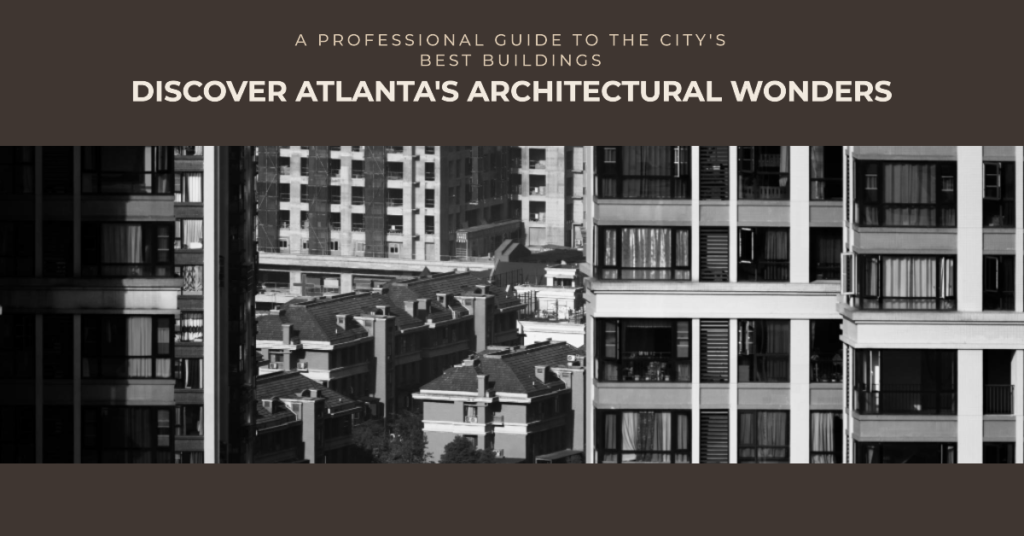
Table of Contents
Introduction:
Atlanta, Georgia, a city steeped in history and innovation, boasts a rich tapestry of architectural marvels that stand as testaments to its past, present, and future. From towering skyscrapers to historic landmarks, each edifice tells a unique story of craftsmanship, vision, and cultural significance. Join us on a captivating journey as we explore Atlanta’s architectural treasures, delving into the intricate details and captivating narratives behind these structures.
A Skyline of Dreams
Atlanta’s skyline is a breathtaking sight to behold, adorned with towering skyscrapers that pierce the heavens and reflect the city’s dynamic spirit. Among them stands the iconic Bank of America Plaza, a shimmering beacon of modern design that dominates the skyline with its sleek glass façade and soaring height. Completed in 1992, this architectural masterpiece remains the tallest building in Atlanta, a symbol of the city’s ambition and prosperity.
Adjacent to the Bank of America Plaza lies the stunning Atlanta Marriott Marquis, renowned for its innovative design featuring a striking atrium with glass elevators that ascend through the heart of the building. Designed by renowned architect John C. Portman Jr., this architectural gem has become an integral part of Atlanta’s skyline, captivating visitors with its futuristic allure.
Historic Landmarks: Guardians of the Past
Amidst Atlanta’s modern skyline, a treasure trove of historic landmarks beckons visitors to step back in time and immerse themselves in the city’s storied past. One such gem is the Fox Theatre, a lavish Moorish-style palace that has enchanted audiences since its opening in 1929. With its opulent décor, including a stunning domed ceiling adorned with twinkling stars, the Fox Theatre transports visitors to a bygone era of glamour and entertainment.
Another architectural gem steeped in history is the Martin Luther King Jr. National Historic Site, encompassing the birth home of the renowned civil rights leader and several other significant landmarks. Visitors can explore the modest house where Dr. King spent his formative years and gain insight into his profound impact on the civil rights movement. The site serves as a poignant reminder of Atlanta’s role in shaping the course of history.
Cultural Icons: Celebrating Diversity and Creativity
Atlanta’s architectural landscape is also enriched by cultural icons that celebrate the city’s vibrant diversity and creative spirit. The High Museum of Art, designed by Pritzker Prize-winning architect Richard Meier, stands as a beacon of artistic excellence, housing a vast collection of contemporary and classical works. Its distinctive white façade and striking geometric forms make it a standout architectural marvel in the heart of Midtown Atlanta.
Venturing further into the city, visitors encounter the Center for Civil and Human Rights, a thought-provoking architectural masterpiece dedicated to promoting understanding and empathy. Designed by renowned architect Philip Freelon, the museum’s striking design features interlocking forms that symbolize the interconnectedness of civil and human rights struggles around the world. Through immersive exhibits and interactive displays, the center invites visitors to explore the ongoing quest for justice and equality.
Parks and Gardens: Nature’s Harmony with Architecture
In Atlanta, nature seamlessly intertwines with architecture, creating serene oases amidst the urban landscape. Piedmont Park, often referred to as the “green heart” of Atlanta, offers a picturesque retreat where visitors can escape the hustle and bustle of the city. Designed by Frederick Law Olmsted, the renowned landscape architect behind New York’s Central Park, Piedmont Park features lush greenery, scenic trails, and stunning views of the city skyline.
Nestled within the park lies the Atlanta Botanical Garden, a verdant paradise that showcases a diverse array of plant species from around the world. Visitors can wander through lush gardens, marvel at captivating sculptures, and immerse themselves in the beauty of nature’s design. From the tranquil beauty of the Japanese Garden to the vibrant hues of the Orchid Display House, the botanical garden offers a feast for the senses.


Educational Institutions: Shaping the Minds of Tomorrow
Atlanta is home to esteemed educational institutions whose architectural splendor reflects their commitment to excellence in learning and research. Emory University, nestled amidst the picturesque Druid Hills neighborhood, boasts a stunning campus characterized by historic architecture and verdant landscapes. From the grandeur of the Emory University Quadrangle to the modernist elegance of the Goizueta Business School, each building reflects the university’s rich heritage and academic prowess.
Georgia Institute of Technology, fondly known as Georgia Tech, is another architectural gem that stands as a beacon of innovation and technological advancement. The campus is dotted with striking modernist buildings, such as the iconic Tech Tower, which serves as a symbol of Georgia Tech’s pioneering spirit. With its state-of-the-art research facilities and collaborative learning spaces, Georgia Tech continues to push the boundaries of innovation in education and beyond.
Neighborhood Gems: Discovering Hidden Treasures
Beyond the bustling city center, Atlanta’s neighborhoods offer a treasure trove of architectural delights waiting to be discovered. In the historic district of Inman Park, Victorian-era homes line tree-lined streets, exuding charm and character. Strolling through the neighborhood, visitors can admire the intricate details of these well-preserved homes and gain insight into Atlanta’s architectural evolution.
The Old Fourth Ward neighborhood, once a hub of industrial activity, has undergone a remarkable transformation in recent years, emerging as a vibrant cultural and residential enclave. The BeltLine, a visionary redevelopment project, has revitalized the area, transforming disused railway tracks into a scenic trail dotted with public art installations and bustling activity hubs. Visitors can explore the neighborhood’s eclectic mix of old and new architecture while soaking in its lively atmosphere.
Iconic Bridges: Connecting Communities and Cultures
Atlanta’s architectural splendor extends beyond its buildings to encompass its iconic bridges, which serve as vital links connecting communities and cultures. The Jackson Street Bridge, made famous by its stunning panoramic views of the Atlanta skyline, has become a beloved landmark and gathering spot for photographers and visitors alike. From sunrise to sunset, the bridge offers unparalleled vistas of the city’s architectural wonders, casting them in a golden glow.
Another iconic bridge is the Sidney Lanier Bridge, spanning the Brunswick River on the outskirts of Atlanta. Named after the renowned poet and musician Sidney Lanier, this majestic cable-stayed bridge is not only a feat of engineering but also a work of art. Its graceful curves and soaring towers create a dramatic silhouette against the backdrop of the coastal landscape, inviting travelers to marvel at its beauty as they journey into the heart of Atlanta.
Futuristic Visions: Innovations in Design and Sustainability
As Atlanta looks to the future, architects are embracing innovative design principles and sustainable practices to shape the city’s evolving skyline. The Mercedes-Benz Stadium, home to the Atlanta Falcons and Atlanta United FC, stands as a shining example of cutting-edge design and environmental stewardship. With its distinctive retractable roof and energy-efficient features, including solar panels and rainwater collection systems, the stadium sets a new standard for sustainable sports venues.
In the heart of Midtown Atlanta, the Coda Building showcases the latest advancements in green building technology and urban design. Designed to achieve LEED Platinum certification, the building boasts energy-efficient systems, green roofs, and innovative water conservation measures. As a hub for technology and innovation, Coda embodies Atlanta’s commitment to creating a more sustainable and resilient built environment for future generations.
Conclusion: Atlanta’s Architectural Tapestry
In conclusion, Atlanta’s architectural landscape is a vibrant tapestry woven from a diverse array of styles, influences, and narratives. From historic landmarks to cutting-edge skyscrapers, each structure contributes to the city’s unique identity and cultural heritage. As Atlanta continues to evolve and grow, its architectural marvels serve as enduring symbols of creativity, innovation, and community. Whether exploring the city’s skyline, historic districts, or green spaces, visitors are sure to be captivated by the rich tapestry of Atlanta‘s architectural splendor.


